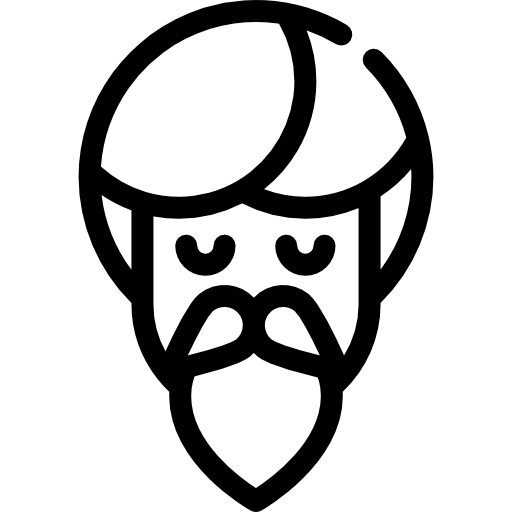
YOGASVARUPE
Tantra and Yantra
Tantra has developed a system of thought which makes us see the universe as if it were within ourselves, and ourselves as if we were within the universe. Further the forces governing the cosmos on the macro-level are believed to govern the individual in the micro-level. According to tantra, the individual being and universal being are one. Thus all that exists in the universe must also exist in the individual body.
One of our major limitations in discovering this essential unity between the microcosm and the macrocosm is that we are accustomed to analyse the world into its separate parts, with the result that we lose sight of those parts' inter-relationship and their underlying unity. The way to fulfilment is through recognition of our wholeness linking man and the universe. This hence is the broad aim of Tantra art, achieved through visual symbols and metaphors.
Encompassing its whole pictorial range, Tantric imagery can be broadly grouped under three heads:
- Geometrical representation of deities as Yantras
- Representation of the Human Body as a Symbol of the Universe
- Iconographic images

Yantra
The Sanskrit word 'yantra' derives from the root 'yam' meaning to sustain, or hold. Hence in metaphysical terms a yantra is visualised as receptacle of the highest spiritual essence.
Swayamvara Yantra: A Yantra is a pure geometric configuration, composed of basic primal shapes. These shapes are psychological symbols correspondinssg to inner states of human consciousness. This innate simplicity of composition is identified with spiritual presence. The use of such elementary shapes is not simplistic but represents the highest conception in visual terms, because the projection of the symbol is then direct and bold, so that even a small miniature can create a sense of expansiveness.

The dynamism of tantric imagery is generated by a quest for geometric order. A yantra represents a particular configuration whose power increases in proportion to the abstraction and precision of the diagram. A yantra gradually grows away from its center, in stages, until its expansion is complete. Around the center are several concentric figures which take part in this expansion. This concentric architecture defines the volume of the yantra and creates a rhythmic unity.
The predominant elementary forms of which yantras are constituted are the point, line, circle, triangle, square and the lotus symbol. All of these forms are juxtaposed, combined, intersected and repeated in various ways to produce the desired objective.
The predominant elementary forms of which yantras are constituted are the point, line, circle, triangle, square and the lotus symbol. All of these forms are juxtaposed, combined, intersected and repeated in various ways to produce the desired objective.
Bindu.
The Point or Bindu.
The Point or Bindu.
In the Brhadaranyaka Upanishad there is the metaphor of a spider sitting at the center of its web, issuing and reabsorbing its threads in concentric circles, all held at one point. The spider's threads symmetrically expand into a visible circumference, but they can all be traced back to the central point of the web.
Like the spider in its web, the center of the yantra is the power-point from which the entire diagram expands, the radiating source of energy that generates all forms. It is the divine essence out of which proceeds the polarized world. It is called Bindu, the first drop, which spreads unfolds, and expands into the tangible realm of the universe. Indeed the optical focus of the yantra is always its center, from which the force lines radiate outwards in concentric circles and dissolve in the outer circumference.
Like the spider in its web, the center of the yantra is the power-point from which the entire diagram expands, the radiating source of energy that generates all forms. It is the divine essence out of which proceeds the polarized world. It is called Bindu, the first drop, which spreads unfolds, and expands into the tangible realm of the universe. Indeed the optical focus of the yantra is always its center, from which the force lines radiate outwards in concentric circles and dissolve in the outer circumference.
On a metaphysical level the Bindu represents the unity of the static (male, Shiva) and the kinetic (female, Shakti) cosmic principles, which expand to create the infinite universe of matter and spirit. A meeting-ground of subject and object, this is exactly the kind of spiritual oneness that the tantra artist strives for. A region where art and artist, creator and viewer merge into a single identity, becoming one with the cosmos as a whole. In the final meditation on the yantra, the Bindu is the region where the ultimate union of the aspirant with the divine takes place.

For the successful creation of a yantra, the artist must look beyond appearances and penetrate to the essence. The center, by virtue of being a dot of zero dimensions, is visualised as the ultimate entity beyond which a thing or energy cannot be contracted or condensed. This infinite reservoir of collective energy is the supremely creative nucleus, and therefore is the repository of all manifestation. As a center, it controls everything which is projected from it; hence it is also called MahaBindu, or the Great Point. It is indeed the starting point of the mental quest for salvation and also the ultimate point in this journey.
According to another school of logic, when a non-manifest stage of existence becomes manifest, its manifestation must begin somewhere, in some point of space, at some point of time. There must be an instant when it has not yet any extension but has begun to have location.
According to another school of logic, when a non-manifest stage of existence becomes manifest, its manifestation must begin somewhere, in some point of space, at some point of time. There must be an instant when it has not yet any extension but has begun to have location.
According to this interpretation, the first instant when a thing does not yet exist and yet has already begun is adequately represented by the dimensionless point.
The Bindu thus contains within itself the two poles' (zero and infinity) and all that lies between. Its inherent energy contains all potentialities and all polarities. In the actual creative process, the Bindu evolves with the help of straight lines into the trikona (triangle).
The Bindu thus contains within itself the two poles' (zero and infinity) and all that lies between. Its inherent energy contains all potentialities and all polarities. In the actual creative process, the Bindu evolves with the help of straight lines into the trikona (triangle).

The Straight Line.
The straight line is composed of an unbroken series of points. These points, moving independently, give length (without breadth) to it. The straight line thus signifies growth and development, and like time, consists of an infinite number of discreet points.
The Triangle
The triangle is the archetype symbol of a sacred enclosure, since space cannot be bounded by fewer than three lines. The triangle is thus conceived as the first closed figure to emerge when creation emerged from chaos. In this aspect it is known as the root of all manifested nature. The rhythm of creation is crystallised in this primal form.
Tantra calls the triangle the cone of fire, a reference to its shape. This is the fire of aspiration which is ever burning in the heart of the spiritual seeker.
Tantra calls the triangle the cone of fire, a reference to its shape. This is the fire of aspiration which is ever burning in the heart of the spiritual seeker.
The threefold structure of the triangle is interpreted over multiple levels. Some of these visualisations are:
1). Creation, Preservation, and Destruction, i.e. Brahma, Vishnu, and Shiva.
2). The three tendencies: the neutral, the positive and the negative - Sattva, Rajas, and Tamas.
3). The three Vedas: Rig, Yajur, and Sam.
4). Past, Present, and Future.
5). The three seasons: Spring, Summer, and Winter.
6). The three main pilgrimages: Prayag, Gaya, and Kashi.
When used in a yantra, a triangle is either inverted or upright. The inverted triangle is a symbol of feminine power, the creative essence of the universe, also known as Shakti.
1). Creation, Preservation, and Destruction, i.e. Brahma, Vishnu, and Shiva.
2). The three tendencies: the neutral, the positive and the negative - Sattva, Rajas, and Tamas.
3). The three Vedas: Rig, Yajur, and Sam.
4). Past, Present, and Future.
5). The three seasons: Spring, Summer, and Winter.
6). The three main pilgrimages: Prayag, Gaya, and Kashi.
When used in a yantra, a triangle is either inverted or upright. The inverted triangle is a symbol of feminine power, the creative essence of the universe, also known as Shakti.

It is the dynamism of this Shakti that gives rise to the creative impulse in nature. This inverted triangle is generally the first enclosure surrounding the infinitesimal nucleus of most yantras.
The triangle pointing upwards is symbolic of the male principle (Purusha). When the two triangles penetrate each other forming a hexagon, it symbolises the fusion of polarities, the union of Shiva and Shakti, male and female. This union is the cause of the manifested universe.
When the triangle’s part at the apex, time and space cease to exist, and all creative activity comes to a standstill. This is shown in the hourglass shape, which is the shape of the Damaru, the drum of Shiva, from which all rhythms of manifestation are said to have emerged. Here it is interesting to note that Panini's treatise on the grammar of Sanskrit, the world's most ancient grammar, states that the Sanskrit language too has proceeded from the rhythms of Shiva's drum.
The triangle pointing upwards is symbolic of the male principle (Purusha). When the two triangles penetrate each other forming a hexagon, it symbolises the fusion of polarities, the union of Shiva and Shakti, male and female. This union is the cause of the manifested universe.
When the triangle’s part at the apex, time and space cease to exist, and all creative activity comes to a standstill. This is shown in the hourglass shape, which is the shape of the Damaru, the drum of Shiva, from which all rhythms of manifestation are said to have emerged. Here it is interesting to note that Panini's treatise on the grammar of Sanskrit, the world's most ancient grammar, states that the Sanskrit language too has proceeded from the rhythms of Shiva's drum.
The Circle
The circle occurs very frequently in yantras and is derived principally from the motion of the revolution of planets. It symbolises wholeness or totality and represents the principle which has no beginning, and no end, for example time. A perfectly symmetrical entity, equidistant from the center at all points; it indicates the realm of radiation that proceeds from the One center. In other words, a circumscribed field of action.
When used in a yantra, a circle is normally placed within a square pattern, described next.
When used in a yantra, a circle is normally placed within a square pattern, described next.

The Square
The square is the fundamental format of most yantras. There is a significant, well thought out logic behind it. The phenomenal world extends into four directions. These four directions represent the totality of space, and they bind the earth in order. The square too is the simplest and perfect manifestation of the number four, by virtue of the four perfect, equal lines bounding its form. Hence it is visualised as the perfect symbol to denote the terrestrial world. This mundane, physical world is the one which must be transcended by spiritual practice.
The square pattern has four gates, one in each of the cardinal directions. They are known as cosmic doors because it is through them that the aspirant symbolically enters the yantra. They represent the passage from the earthly realm to the 'inner', sacred space of the yantra. These gates are an initiatory threshold which simultaneously opposes the phenomenal and embraces the noumenal. It is further believed that these gateways themselves are guarded by divine forces which protect the sacred precinct within, from negative and disintegrating forces.

The Lotus
Potent as it is, in tantric art the lotus is a symbol of the expanding consciousness, which ultimately raises the aspirant from the dark depths of ignorance to the radiant heights of inner awakening. Because of its smooth and oily surface the lotus is not affected by the water in which it grows. Hence just as the lotus plant grows in the 'darkness of mud' and gradually blossoms out to the surface of water, unsullied by the mud and water which nourishes it, so the inner-self transcends beyond its own material limits, uncorrupted and untarnished by illusion and ignorance.
Lord Vishnu with Lakshmi on Sheshnag. The lotus blossom is one of the principal archetypal symbols used in yantras. Generally centered on the axis with its petals unfolding towards the circumference, it is the appropriate image to illustrate the unfolding of power of the divine essence. Because of its associations with progression, development and the life-expanding quality, the lotus represents the 'out-petalling' of the soul-flower in the process of spiritual realisation. Hence in ancient cosmology, the lotus is also associated with creation myths. It is, for example, often depicted as springing from Vishnu's navel, supporting and giving birth to Brahma, the creator.

Dash Avataar - The Ten Incarnations of Vishnu
Once Brahma creates the universe, Vishnu comes to the world in one of his ten forms or incarnations, to preserve order and ensure justice.
Shiva's Taandava
This is one of the cycles of creation. At its end, Shiva dances and the universe is destroyed.
Brahma falls asleep, and the lotus closes and goes back into Vishnu's navel. Vishnu then sleeps on the serpent's coils. The process eventually begins all over again. The lotus hence here represents the unfolding of a new age (Yuga in Sanskrit); similarly in a yantra it signifies the awakening of the inner self.
Brahma falls asleep, and the lotus closes and goes back into Vishnu's navel. Vishnu then sleeps on the serpent's coils. The process eventually begins all over again. The lotus hence here represents the unfolding of a new age (Yuga in Sanskrit); similarly in a yantra it signifies the awakening of the inner self.

Sri Ganesha Yantra
Since the earliest times, the lotus has always been a symbol of the citadel of the heart, the seat of the Self. Yogis believe that there are actual spiritual centers within us whose essential nature and luminosity can be experienced during meditation. These spiritual centers are often represented symbolically as lotuses, and their 'opening up' implies the state of complete repose when the purpose of yogic meditation is attained.
In the final analysis, though a yantra is made up of different elements, the fundamental aim of ritual and meditation is to fuse all these dimensions, and to facilitate the adept's spiritual journey, as follows:
The outermost square sanctuary has a landing before each of its four gates. This is a two dimensional representation of a low flight of steps leading up from the ground to the raised floor of the sanctuary. This sanctuary is the seat of the divinity. This is exactly the model on which the Hindu temple is built. Hence each Hindu temple is a yantra in itself.
The outermost square sanctuary has a landing before each of its four gates. This is a two dimensional representation of a low flight of steps leading up from the ground to the raised floor of the sanctuary. This sanctuary is the seat of the divinity. This is exactly the model on which the Hindu temple is built. Hence each Hindu temple is a yantra in itself.

Once the spiritual seeker enters the square enclosure, and starts moving towards the center, the symbol of the flowering lotus represents the awakening of his/her inner consciousness to its maximum potential. As the journey progresses, the adept encounters the various aspects of manifestation inherent in nature, symbolised by the male and female principles (the triangles). These are bounded within a circle. This symbolises that all reality is confined within these concepts. The journey towards the center encompasses both distance and the course of time. This space time continuum is represented by the straight line.
Finally the devotee reaches the center, the reservoir of all knowledge and the final goal of his journey. But the spiritual awareness generated within him during his penetration to the central essence makes him realise that this point is nothing but the center of his own heart, the innermost realm of his being. This realisation is the ultimate aim of the yantra.
Finally the devotee reaches the center, the reservoir of all knowledge and the final goal of his journey. But the spiritual awareness generated within him during his penetration to the central essence makes him realise that this point is nothing but the center of his own heart, the innermost realm of his being. This realisation is the ultimate aim of the yantra.
Bharatnatyam Mudra
Iconographic Images
Iconographic Images
In tantric art, an image created must correspond to the original canonical text; any omission, error or oversight is attributed to imperfect absorption or considered a sign of slackening of attention. In such an event, the image is discarded and the process of composing is deferred.
Shiva Linga
The process of image-making is an yoga discipline in itself. It is also believed to lead to spiritual deliverance. This belief shifts the objective of art from being an end in itself to being the means of an end. The intention of the artist is to express fundamental truths which are constant for all, and not just his own 'personal' truth. His path thus is one of selfless action, where there is a total annihilation of the ego. In such an art, it comes as no surprise therefore, that the artist has always remained anonymous.
But it is not that the creative impulse of the artist is stifled. The artist while undertaking creative activity intuitively realises that his own self-expression is part of a universal and collective expression as a whole. This underlying unity acts as an awesome catalyst, convincing him of the sacred nature of his activity, and prompts him to adopt universal symbols in his creations. The Shiva-linga for example, is a balancing of the masculine and feminine ways of the world. This archetypal symbol has been in existence even before the idea of history itself. The enduring popularity of its essential iconography is a pointer to its acceptance in universal psychology.

Because of the vital nature of the task, ancient texts dwell at length on the qualities an artist must possess before he can embark on this spiritual journey. A tantric text for example, enumerates the following six essentials that a stone-carver must master:
The knowledge of stones.
The compositional diagram.
The carving and dressing of stone.
The arrangement of the various elements of a sculpture.
The representation of the essential mood-character of a piece.
The final integration of all its component parts.
The making of an iconographic image in Tantra art is considered the equivalent of the highest form of worship. This activity is seen as capable of opening up spiritual avenues for those who seek them. Accordingly the canonical texts set the highest standards for those who wish to traverse this path.
The knowledge of stones.
The compositional diagram.
The carving and dressing of stone.
The arrangement of the various elements of a sculpture.
The representation of the essential mood-character of a piece.
The final integration of all its component parts.
The making of an iconographic image in Tantra art is considered the equivalent of the highest form of worship. This activity is seen as capable of opening up spiritual avenues for those who seek them. Accordingly the canonical texts set the highest standards for those who wish to traverse this path.
Conclusion
The art which has evolved out of tantra reveals an abundant variety of forms, varied inflections of tone and colors, graphic patterns, powerful symbols with personal and universal significance. It is especially intended to convey a knowledge evoking a higher level of perception, and tapping dormant sources of our awareness. This form of expression is not pursued like detached speculation to achieve mere aesthetic delight, but has a deeper meaning. Apart from aesthetic value, its real significance lies in its content, the meaning it conveys, and the philosophy of life it unravels. In this sense tantra art is visual metaphysics.





